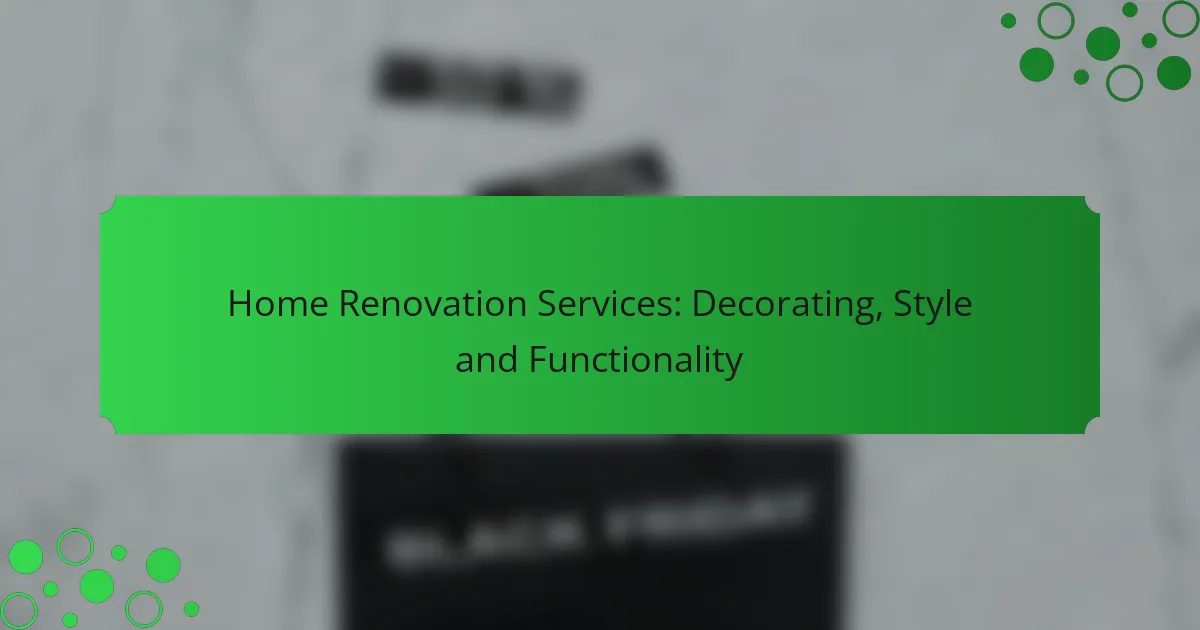Transforming your home through renovation services can enhance both its aesthetic appeal and functionality. From stylish kitchen upgrades to exterior enhancements, it’s essential to choose a contractor who understands local design trends and offers quality craftsmanship. By evaluating qualifications and transparency in pricing, homeowners can ensure a successful renovation project that meets their unique needs.

What are the best home renovation services in Los Angeles?
The best home renovation services in Los Angeles focus on quality, style, and functionality, catering to various needs from kitchen upgrades to exterior enhancements. Homeowners should prioritize services that offer comprehensive solutions, skilled craftsmanship, and a strong understanding of local design trends.
Kitchen remodeling services
Kitchen remodeling services in Los Angeles typically include updating cabinetry, countertops, and appliances to create a more functional and aesthetically pleasing space. Homeowners should consider their cooking habits and family needs when planning a remodel, as this can influence layout and design choices.
Budgeting is crucial; kitchen remodels can range from a few thousand dollars for minor updates to tens of thousands for a complete overhaul. It’s advisable to get multiple quotes and check references to ensure quality workmanship.
Bathroom renovation services
Bathroom renovation services encompass everything from simple updates like new fixtures to full-scale remodels that may involve reconfiguring the layout. Key considerations include maximizing space, improving water efficiency, and enhancing comfort with features like heated floors or walk-in showers.
Costs can vary widely, with minor renovations starting in the low thousands and major projects reaching upwards of $20,000. Homeowners should prioritize functionality and durability in materials to ensure long-term satisfaction.
Interior design services
Interior design services help homeowners create cohesive and stylish spaces that reflect their personal tastes. This can involve selecting color schemes, furniture, and decor that harmonize with the home’s architecture and the client’s lifestyle.
Working with a designer can streamline the renovation process, as they can provide access to exclusive materials and resources. It’s beneficial to establish a clear budget and style preferences upfront to guide the design process effectively.
Exterior home improvement services
Exterior home improvement services focus on enhancing curb appeal and functionality, including landscaping, siding, and roofing. These services not only improve aesthetics but can also increase property value and energy efficiency.
Homeowners should consider local climate conditions when selecting materials and designs. Regular maintenance and updates can prevent costly repairs in the long run, making it wise to invest in quality services that offer warranties and ongoing support.

How to choose a home renovation contractor?
Choosing a home renovation contractor involves evaluating their qualifications, reputation, and transparency in pricing. A well-selected contractor can significantly impact the success of your renovation project.
Check credentials and licenses
Start by verifying that the contractor holds the necessary licenses and certifications required in your area. This may include general contractor licenses, liability insurance, and worker’s compensation coverage. In the United States, for example, licensing requirements vary by state, so ensure you understand local regulations.
Additionally, check if the contractor is a member of professional organizations, which can indicate a commitment to industry standards. This may include affiliations with groups like the National Association of Home Builders (NAHB) or similar local entities.
Read customer reviews
Customer reviews provide insight into a contractor’s reliability and quality of work. Look for feedback on platforms such as Google, Yelp, or specialized home improvement websites. Pay attention to both positive and negative reviews to get a balanced view.
Consider reaching out to past clients for direct testimonials. Ask about their experience regarding communication, adherence to timelines, and overall satisfaction with the completed project.
Request detailed estimates
When requesting estimates, ensure they are detailed and itemized. A comprehensive estimate should break down costs for materials, labor, and any additional fees. This transparency helps you understand where your money is going and allows for better comparisons between contractors.
Be wary of estimates that seem significantly lower than others, as they may indicate hidden costs or subpar materials. Aim for estimates that fall within a reasonable range based on your project’s scope and complexity.

What are the costs associated with home renovation?
Home renovation costs can vary significantly based on the scope of the project, materials used, and labor expenses. Understanding these costs is essential for budgeting and planning your renovation effectively.
Average kitchen renovation costs
The average kitchen renovation costs typically range from several thousand to tens of thousands of dollars, depending on the extent of the updates. A minor remodel may start around $10,000, while a major overhaul can exceed $50,000.
Key factors influencing kitchen renovation costs include cabinetry, countertops, appliances, and flooring. For instance, custom cabinets and high-end appliances can significantly increase your budget.
Average bathroom renovation costs
Bathroom renovation costs generally fall between a few thousand and over $20,000, depending on the changes made. A basic remodel might cost around $5,000, while luxury upgrades can push the price much higher.
Factors such as fixtures, tile work, and plumbing updates play a crucial role in determining the final cost. Opting for standard fixtures instead of luxury brands can help keep expenses manageable.
Cost factors for interior design
Interior design costs can vary widely based on the designer’s experience, project complexity, and materials selected. Hiring a professional designer typically adds a percentage to your overall renovation budget, often ranging from 10% to 20%.
When considering interior design, think about the style you want to achieve, the functionality of the space, and the quality of materials. Balancing aesthetics with practicality can help you avoid overspending while still achieving your desired look.

What styles are popular in home renovations?
Popular styles in home renovations reflect current trends and personal preferences, emphasizing aesthetics and functionality. Homeowners often choose styles that enhance their living space while aligning with their lifestyle needs.
Modern minimalist style
Modern minimalist style focuses on simplicity and functionality, characterized by clean lines, open spaces, and a neutral color palette. This approach often incorporates natural materials and emphasizes decluttering to create a serene environment.
When adopting a modern minimalist style, consider using furniture with sleek designs and choosing decor that serves a purpose. Avoid overcrowding spaces with excessive decorations, and instead, opt for a few statement pieces that enhance the overall aesthetic.
Rustic farmhouse style
Rustic farmhouse style combines charm and comfort, featuring natural materials like wood and stone, along with vintage accents. This style often includes elements like exposed beams, shiplap walls, and a warm, inviting color scheme.
To achieve a rustic farmhouse look, focus on incorporating reclaimed wood furniture, soft textiles, and antique accessories. Mixing modern appliances with traditional decor can create a balanced and functional space while maintaining the cozy feel of a farmhouse.
Industrial chic style
Industrial chic style draws inspiration from warehouses and factories, showcasing raw materials such as metal, brick, and concrete. This style often features open spaces, high ceilings, and a mix of vintage and modern furnishings.
For an industrial chic renovation, consider using metal fixtures, large windows, and a neutral color palette with bold accents. Be mindful of balancing hard surfaces with softer elements like plush rugs and comfortable seating to avoid a cold atmosphere.

What are the benefits of professional home decorating?
Professional home decorating offers numerous advantages, including enhanced aesthetics, increased functionality, and improved property value. By leveraging expert skills, homeowners can achieve a cohesive design that reflects their style while optimizing space.
Expert design advice
Hiring a professional decorator provides access to expert design advice tailored to your specific needs. These professionals understand current trends and timeless styles, helping you create a space that is both stylish and functional.
Considerations such as color schemes, furniture placement, and lighting can significantly impact the overall feel of your home. A decorator can guide you through these choices, ensuring that every element works harmoniously together.
Access to quality materials
Professionals often have established relationships with suppliers, granting you access to high-quality materials that may not be available to the general public. This can include premium fabrics, unique furnishings, and sustainable options that enhance both aesthetics and durability.
Investing in quality materials can lead to long-term savings, as they tend to last longer and require less maintenance. Additionally, a decorator can help you find the best options within your budget, ensuring you get value for your money.
Time-saving project management
Professional decorators manage the entire renovation process, saving you valuable time and reducing stress. They coordinate schedules, oversee contractors, and ensure that projects stay on track, allowing you to focus on other priorities.
By handling logistics and troubleshooting issues as they arise, decorators help prevent common pitfalls that can lead to delays or budget overruns. This streamlined approach not only saves time but also enhances the overall experience of your home renovation project.

How to incorporate functionality into home design?
Incorporating functionality into home design means creating spaces that are not only aesthetically pleasing but also practical for everyday use. This involves thoughtful planning of layouts, furniture, and storage solutions to enhance usability while maintaining style.
Space optimization techniques
Space optimization techniques focus on maximizing the utility of available areas in your home. Consider using vertical storage solutions, such as shelves and cabinets that reach the ceiling, to free up floor space. Additionally, open floor plans can create a sense of spaciousness while allowing for flexible use of the area.
Another effective method is to declutter regularly and choose furniture that can be easily moved or rearranged. For instance, using area rugs can define spaces without permanent walls, making it easier to adapt the layout as needed.
Multi-functional furniture options
Multi-functional furniture is designed to serve more than one purpose, making it ideal for maximizing space in smaller homes. Examples include sofa beds, ottomans with storage, and dining tables that can expand for guests. These pieces not only save space but also enhance the functionality of your living areas.
When selecting multi-functional furniture, consider your lifestyle and how often you entertain or need additional sleeping arrangements. Investing in high-quality, durable options can provide long-term benefits, ensuring that the furniture remains stylish and functional over time.
